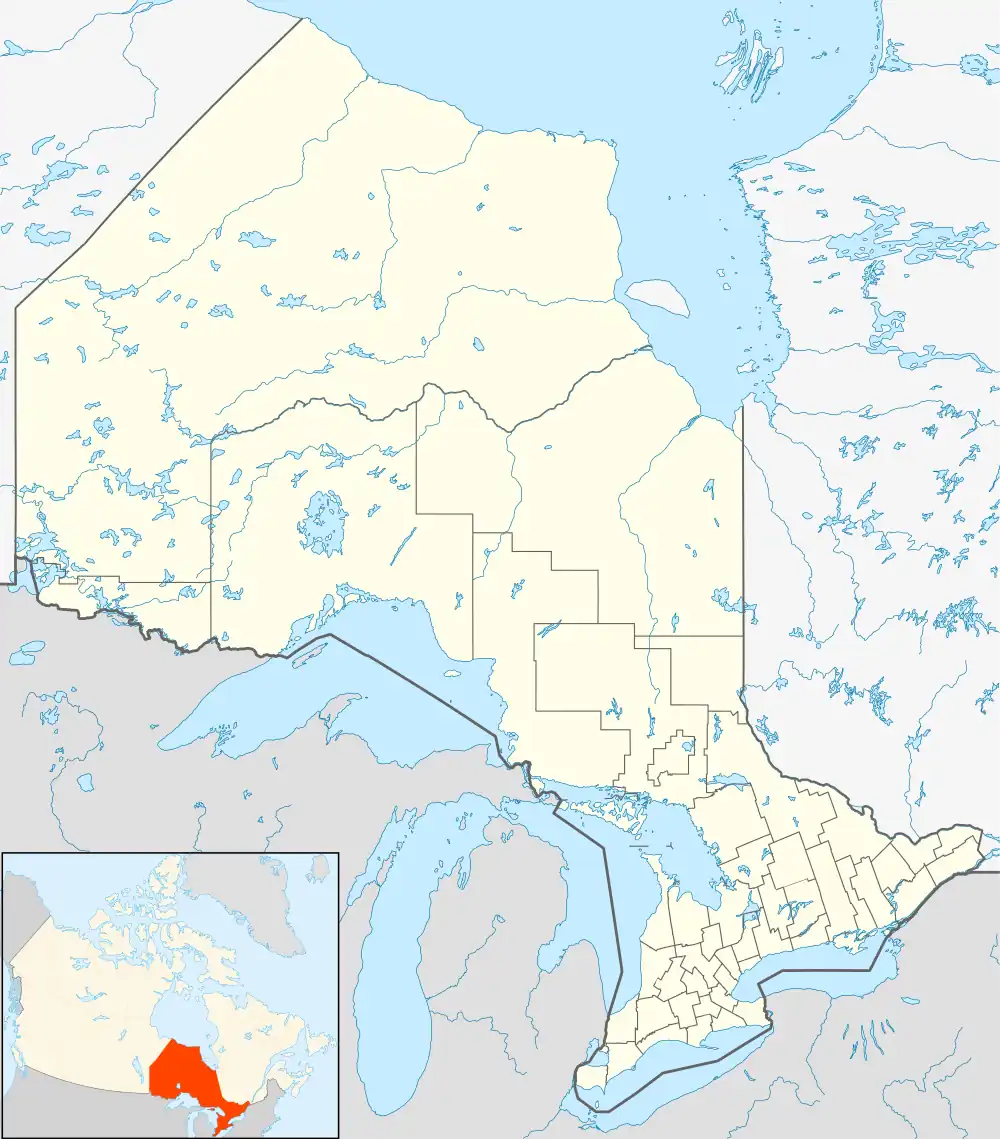 The mine in 1956 | |
| Location | |
|---|---|
 Bicroft Mine Location in Bancroft, Ontario  Bicroft Mine Bicroft Mine (Southern Ontario)  Bicroft Mine Bicroft Mine (Ontario) | |
| Location | Cardiff |
| Province | Ontario |
| Country | Canada |
| Coordinates | 44°59′30.39″N 78°2′16.83″W / 44.9917750°N 78.0380083°W |
| Production | |
| Products | Uranium oxide |
| Production | 2,333,106 tonnes |
| History | |
| Opened | 1957 |
| Closed | 1963 |
| Owner | |
| Company | Barrick Gold |
Bicroft Mine is a decommissioned underground uranium mine, located in Cardiff, near Bancroft, Ontario, Canada.
It is one of fourteen former uranium mines in Ontario that is monitored by the Canadian Nuclear Safety Commission, and one of twenty in Canada.
Aside from uranium, the mine has also produced globally renowned samples of Kainosite-(Y).
Location
Bicroft Mine is a decommissioned former underground uranium mine in Cardiff, 19 kilometres (12 mi) southwest of Bancroft, Ontario, Canada.[1]
It is one of four former mines near Bancroft - the others being Faraday Mine/Madawaska Mine, Dyno Mine, and Greyhawk Mine.[2] It is also one of fourteen former uranium mines in Ontario that is monitored by the Canadian Nuclear Safety Commission, and one of twenty of such in Canada.[3]
Products
Aside from uranium, the mine has also produced globally renowned samples of Kainosite-(Y).[4]
Discovery of uranium - 1922 to 1953
Uranium was first discovered in the area of Cardiff in 1922 by W. M. Richardson. Between 1953 and 1956, one hundred area prospects were opened, including one by Central Lake Uranium Mines Limited that later turned into Bicroft Mine.[5]
Mining operations - 1953 to 1960
The mine operated from 1957 to 1963 and produced 2,333,106 tonnes of uranium ore[6] at an average concentration of 19 mg of uranium per kg of ore.[7] The 2,284,421 tonnes of tailings are deposited in two impoundments near Cardiff:[2][8] Auger Lake and South Tailings Basin which flow into Paudash Lake.[1]
The mine employed up to 500 people at its peak.[9]
Bicroft Mine was originally owned by Bicroft Uranium Mines Limited,[10] and is now owned by Barrick Gold.[11][12][13]
Closure and decommissioning - 1960 to present day
Repairs to the decommissioned site, included adding vegetation over the tailings, were completed in 1980. Subsequent upgrades of the dams were completed in the 1990s.[12][8][14] The site is now a wetland.[1]
Water sampling completed by the Canadian Nuclear Safety Commission in 2019 confirmed that the site produces no risk to the environment or ecology.[12]
In September 2020, Barrick Gold requested to renew their waste nuclear substance license.[15] The Canadian Nuclear Safety Commission renewed the license on 24 February 2021.[15] The license will expire on 29 February 2036.[15]
See also
References
- 1 2 3 Canada, Library and Archives (2019-03-08). "Search - Theses Canada". www.bac-lac.gc.ca. Archived from the original on 2023-07-03. Retrieved 2021-11-22.
- 1 2 Laidlow, Allison (6 May 2013). Characterization of Uranium and Rare Earth Element Mobility and Attenuation Downstream of Decommissioned Tailings Impoundments at the Bicroft Mine near Bancroft, Ontario (Thesis). hdl:1974/8022.
- ↑ "Uranium mines and mills waste". Canadian Nuclear Safety Commission. 2014-02-03. Archived from the original on 2014-02-27. Retrieved 2021-11-22.
- ↑ McDougall, Raymond (2019-09-03). "Mineral Highlights from the Bancroft Area, Ontario, Canada". Rocks & Minerals. 94 (5): 408–419. doi:10.1080/00357529.2019.1619134. ISSN 0035-7529. S2CID 201298402.
- ↑ Reynolds, Nila (1979). Bancroft. A Bonanza of Memories. Bancroft Centennial Committee. p. 192.
- ↑ Mohamad, Bin Daud (June 1980). A Study of Uranium in Ground Water Around Greyhawk Mine, Bancroft, Ontario (Thesis). hdl:11375/6845. Archived from the original on 2023-03-18. Retrieved 2023-07-03.
- ↑ Parsons, Michael B.; Friske, Peter W. B.; Laidlow, Allison M.; Jamieson, Heather E. (2014). "Abstract: Controls on Uranium, Rare Earth Element, and Radionuclide Mobility at the Decommissioned Bicroft Uranium Mine, Ontario". Archived from the original on 2021-11-22. Retrieved 2021-11-22.
{{cite journal}}: Cite journal requires|journal=(help) - 1 2 "Independent Environmental Monitoring Program: Dyno, Bicroft, and Madawaska Mines". Canadian Nuclear Safety Commission. 2020-09-21. Archived from the original on 2020-11-01. Retrieved 2021-11-22.
- ↑ "Uranium Citizens Inquiry". www.uraniumcitizensinquiry.com. Archived from the original on 2017-04-19. Retrieved 2021-11-22.
- ↑ Evans, A. M. (1966-12-01). "The development of lit-par-lit gneiss at the Bicroft uranium mine, Ontario". The Canadian Mineralogist. 8 (5): 593–609. ISSN 0008-4476. Archived from the original on 2021-11-22. Retrieved 2021-11-22.
- ↑ "3 decommissioned uranium mines near Bancroft, Ont. deemed protected, no health impacts: study - Peterborough | Globalnews.ca". Global News. Archived from the original on 2023-03-18. Retrieved 2021-11-22.
- 1 2 3 "Sampling near old mine sites finds 'no expected health impacts'". Haliburton Echo. 2020-10-06. Archived from the original on 2023-03-18. Retrieved 2021-11-22.
- ↑ Smith-Millar, Trevor (2020-10-15). "Old Uranium Mines in Bancroft Area Deemed Safe". My Bancroft Now. Archived from the original on 2020-11-26. Retrieved 2021-11-22.
- ↑ "Subsurface Investigations and Condition of Dams: Bicroft Mine Site Bancroft, Ontario · U-Links Centre For Community Based Research". database.ulinks.ca. Archived from the original on 2021-11-22. Retrieved 2021-11-22.
- 1 2 3 "Regulatory Oversight Report for Uranium Mines, Mills, Historic, and Decommissioned Sites in Canada: 2020" (PDF). Canadian Nuclear Safety Commission: 160. Archived (PDF) from the original on 2022-09-15. Retrieved 2021-11-29.